Digital test breakthrough links brain chemistry to cognitive health
A revolutionary digital assessment that measures brain chemistry in just three minutes has been validated against direct neuroimaging for the first time, offering new possibilities for early detection of cognitive decline and dementia. The breakthrough research demonstrates that a self-administered computerised test can accurately reflect levels of acetylcholine, a crucial neurotransmitter whose decline signals cognitive impairment progression.
The study, published in JMIR Formative Research on 7 July 2025, represents the first brief computerised cognitive assessment validated against cholinergic neurotransmission using positron emission tomography (PET) imaging. Researchers from Posit Science Corporation and McGill University examined 92 healthy older adults aged 65-83 years, comparing performance on the “Double Decision” assessment with direct brain imaging measurements.
Revolutionary approach to brain health monitoring
“Currently, it’s impossible for doctors to monitor this brain chemical despite its importance because it requires expensive imaging equipment and special expertise available at few research centres,” said Dr Henry Mahncke, CEO of Posit Science. “This breakthrough shows a new path for routine monitoring of brain health by doctors and individuals.”
The assessment focuses on the cholinergic system, which produces acetylcholine – often called the “pay attention” chemical because it is produced when concentration is required. Acetylcholine production naturally decreases with normal aging and declines even more severely in pre-dementia and Alzheimer’s disease.
The Double Decision assessment evaluates visual processing speed and selective attention through a dual-task paradigm. Participants simultaneously identify a vehicle at the centre of their screen while locating a specific sign in their peripheral vision. The test adapts by adjusting exposure duration based on performance, with raw scores representing the time needed to achieve approximately 80% accuracy.
Strong correlation with brain imaging
The research demonstrated a significant negative correlation between Double Decision performance and acetylcholine transporter binding in the anterior cingulate cortex, explaining 8% of the variance in neurotransmitter levels. Better (faster) performance on the assessment correlated with higher cholinergic function, as measured by [18F]fluoroethoxybenzovesamicol (FEOBV) PET imaging.
“The results support the adoption of this scalable form of biomarker-informed cognitive assessment available to individuals with an internet-connected device,” the researchers concluded. The assessment was sensitive to age within the 65-83 year range and remained uninfluenced by education level or gender.
Performance on the assessment also correlated significantly with the NIH EXAMINER executive composite score and showed trending associations with the Montreal Cognitive Assessment (MoCA), supporting its validity against established neuropsychological measures.
Addressing critical healthcare gap
Current methods for measuring cholinergic function remain prohibitively expensive and inaccessible. PET imaging requires specialised expertise, exposes participants to radiation, and costs make routine monitoring impractical. No standardised blood test exists for direct measurement of acetylcholine function.
The authors emphasised the clinical significance: “This brief, self-administrable assessment tool offers a scalable approach to cognitive screening, requiring only an internet-connected device. Broad accessibility makes Double Decision valuable for widespread use in community-based health initiatives, primary care settings, and clinical trials.”
The assessment may prove particularly beneficial for individuals in remote or underserved areas where access to traditional neuroimaging or comprehensive neuropsychological assessment is limited or cost-prohibitive.
Clinical applications and future directions
The research opens new avenues for cognitive health monitoring across multiple contexts. The assessment could serve as an initial community-based screening tool for individuals experiencing subtle memory lapses, those with family histories of dementia, or people with known risk factors such as cardiovascular disease or metabolic disorders.
“It may be used to monitor cognitive trajectories over time, identifying individuals who may benefit from further neuropsychological evaluation or early pharmacological or lifestyle interventions aimed at preserving cognition,” the authors noted.
In large-scale epidemiological studies, the tool could facilitate identification of population-level cognitive health trends, enabling researchers to assess how genetics, lifestyle, or environmental factors contribute to cognitive aging. For clinical trials, it may serve as a measure to evaluate intervention efficacy in altering cholinergic function.
Limitations and validation
The study population showed limited demographic diversity, with 96% of participants identifying as White, potentially limiting generalisability to other racial and ethnic groups. The research was also restricted to healthy older adults aged 65 and above with MoCA scores between 23-30.
However, the investigation represents the largest FEOBV-PET study to date, employing rigorous methodology with stringent inclusion criteria and a prespecified statistical analysis plan focused on a predefined region of interest.
Reference
Attarha, M., De Figueiredo Pelegrino, A., Ouellet, L., et. al. (2025). Association of a Brief Computerized Cognitive Assessment With Cholinergic Neurotransmission: Assessment Validation Study. JMIR Formative Research, 9, e68374. https://doi.org/10.2196/68374


